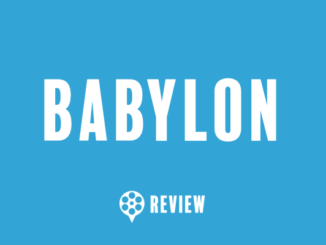Who cares what critics say if your movies make a profit? This was the attitude as Friday the 13th Part III would be unleashed upon us only a year after the second film. The big question was how does the studio not make this more of the same? The first major idea was the inclusion of 3D, which was pretty big at the time of its 1982 release. The gimmick alone guarantees a bit of a boost at the box office. The next change was taking it out of the traditional camp counselor setting and presenting the film at a cabin with characters who were unfamiliar with Jason Voorhees or the mayhem at Camp Crystal Lake. In fact, this is the only film in the franchise where Jason isn’t referenced to by name.
The changes are essential to making the third film work. It’s not high art but it’s fun and made with a bit more energy than the second film. The characters are a bit more fun and Jason, while not as scary this time around, is still very imposing. It doesn’t feel as familiar and that is what makes it stand out, for me, as the best sequel of the bunch.
This is also the film in which Jason loses the burlap sack and dons his signature hockey mask. I don’t think they knew it would become so iconic back in 1982 but it is certainly one of the most enduring images of horror. It transcended the franchise and became a part of pop culture that has lasted for years after its inception.

Whether it was the 3D or some new energy, the changes paid off for the film. The film opened to $9 million, which was higher than the previous two films and went on to gross $36.6 million on a $2.3 million budget. I would say the success of this film really pushed the franchise into true pop culture territory but with success comes backlash.
The film was still blasted by critics and I believe this is when Paramount Pictures started to feel the heat a bit. Despite profit, the studio had to accept that they were releasing inferior films, by critics standards, and that they would probably never earn the studio any respect. This could be why there was a two-year gap between Part III and the next sequel and why the studio decided to kill Jason off for good.
Judging from its title, Friday the 13th: The Final Chapter was supposed to be endgame. The studio would kill off the character and concept that made them so much money and, by doing so, maybe they could earn a little respect for stopping it despite its success. It really feels like that was the route they were taking since they did bring back Tom Savini, who didn’t work on the second or third film, to make some killer gore effects and kill off the monster helped create during the final moments of the first film.
The film certainly goes all out like it’s not going to be invited to the party anymore. The gore is pretty intense. The kills are visceral and the film is a darker than the ones that came before it. Jason feels more violent this time around and it makes his demise a true payoff in the end. The film is also littered with some impressive talent and game cast. Kimberly Beck is an effective heroine as Trish and her little brother, admirably played by Corey Feldman, makes for a nice touch as our final girl not only has to protect herself but protect him as well. There are also other victims on display and they’re nearly as likable as the characters from the previous film but that film didn’t have Crispin Glover, whose quirkiness is much appreciated in this installment.
The film was embraced like it was a final chapter. It opened to the highest opening weekend for the franchise at the time with $11.1 million and went on to gross $32.9 million on a $2.6 million budget. Critics still hated it but who cares! This was the last hurrah and the films ended on a financial high note so Paramount could move on and focus on other endeavors.
Now it’s 1985 and a new beginning is upon us. A studio can’t ignore a profit like that and even though they said the last film was it, they knew they could go back on that word and people would most likely eat it up. They were about half right on that one because the end result, Friday the 13th: A New Beginning would turn out to be a very polarizing entry in the franchise.
Since Jason was killed off in the previous film, how do you do Friday the 13th without him? Easy! You make it appear that Jason has returned and then pull the rug out of the audience by making the culprit a copycat killer. I’ll be honest and say that I actually have fun with this one but I can see why fans don’t exactly embrace this film. It wants to go for psychological horror by giving us a killer who is driven mad by the murder of his son at a halfway house but the franchise has never really been known for its intelligence so those nuances get lost in a plot driven by intense gore, sex, and nudity. At the time, this film was heavily picked apart by the MPAA and is still ranked among fans as being the film in the franchise that feels the most gratuitous. Maybe they felt they needed to up that ante because they knew they wouldn’t be offering up the real Jason Voorhees. It doesn’t help that the characters aren’t all that memorable and we don’t get a heroine that stands out. Tommy Jarvis, played by Corey Feldman in the previous film and briefly during the opening of this film before being aged to be played by John Shepard, doesn’t offer up much since he’s pretty much mute for most of the film. If you have thankless characters drenched in gore, the film truly becomes what the critics hate.
The difference this time around is that audiences and critics didn’t care for the film too much. The film turned a profit after opening to $8 million and finishing with $21.9 million on a $2.2 million budget but I think some box office was lost because fans felt cheated by the end result. Many fans still don’t consider this a true Friday the 13th film and it’s not thought of too fondly, although there is a bit a small cult following who appreciate it for what it is.
Could Paramount be done with the Friday the 13th franchise now?
Nope! After the fifth film, we enter the zombie Jason era of the franchise and as silly as that sounds, it actually starts on the right note with Jason Lives: Friday the 13th Part VI. The studio decides to bring Jason back, no matter how silly the notion, but they also have a bit of fun with the concept that makes it one of the better sequels from the back end of the franchise.
The filmmakers embrace how silly the concept is and run with it. The film is played for much more humor than the previous films and it takes on a bit of a self-referential approach that allows it a few occasions to break the fourth wall a bit. It doesn’t break exciting new ground but it definitely allows it to feel fresh for a film that in its sixth installment.
This is a sequel that is considered a fan favorite. It’s not my favorite of the bunch but I can see why it’s so loved by many and even some critics embraced this one as well. A quote from Gene Siskel at the time saying it was “the least offensive film of the most offensive film series ever” seems like high praise considering how he felt about the first film. This sequel holds a 52% on Rotten Tomatoes, which is one of the better showings from the sequels.
Despite the fan love, the sequel suffered from the beginning of slasher movie fatigue. The film opened to $6.7 million (down from the previous film) and was the first in the franchise to gross less than $20 million with a final gross of $19.4 million. In fact, the franchise wouldn’t see a gross above $20 million until the horror match up presented in Freddy vs. Jason.
Despite a lower final gross, the film only cost $3 million to make so a profit was still made. This is why we got another film in the franchise with Friday the 13th Part VII: The New Blood. The film was released in 1988, two years after the previous film, but the year is significant because before the film we got, this entry was supposed to be much different.
This is around the time talks of Freddy vs. Jason began. Both franchises were huge at the time but A Nightmare on Elm Street broke the pop culture barrier even more back in the 80’s. It made sense to put these two together but Paramount (who owned the rights to Friday the 13th) and New Line Cinema (who owned the rights to A Nightmare on Elm Street) couldn’t come to an agreement to bring the franchises together. It’s an agreement that wouldn’t happen until the release of the ultimate showdown in 2003 (more on that later).
What we got instead is a Carrie meets Friday the 13th scenario that takes a troubled girl with telekinetic powers and pits her against Jason. It’s an interesting showdown because, despite her vulnerability, she is probably his strongest adversary. Lar Park Lincoln is easily the best heroine of the latter sequels and a nice break from the Tommy Jarvis character (he returned in the previous film, once again played by another actor).
This installment stands out because the previous films had different people playing Jason in each film but this marks the beginning of the Kane Hodder era. He would go on to play the character in three more films after this one and he is easily a fan favorite because you can tell, without him uttering a word, that he loves playing the part. He gives the role a bit of an impact and even when the sequels he was in got more absurd, he continued be the best thing about them.
Also of significance is how much this film was cut to avoid an X-rating. This sequel is stuff of legend a bit because while the previous films were butchered a bit by the MPAA, you can really tell in this film and it takes a bit away from its impact. Fans have always wanted to see the film as it was intended but all we have is a pretty bad workprint footage presented as deleted scenes on DVDs but Paramount apparently destroyed the more pristine versions of these cut scenes so we will sadly never see them they way we were supposed to.
Perhaps the two-year gap helped the film on opening weekend because it opened to $8.2 million (higher than the previous film) but it ultimately stalled at $19.2 million. Again, this was due to both slasher and growing fatigue with the franchise rather than the film itself. It’s regarded as highly as the previous film but at the time it was one of many films of its type that came and went fairly quickly. It’s $2.8 million budget still guaranteed the studio made a profit on the film.




